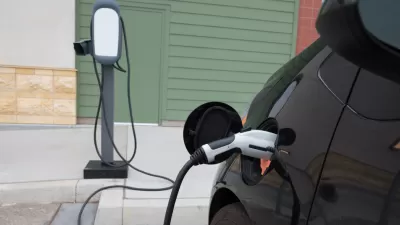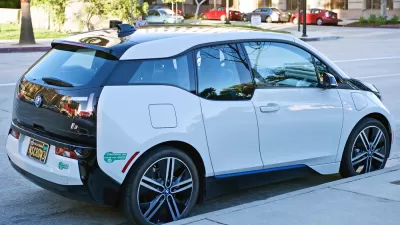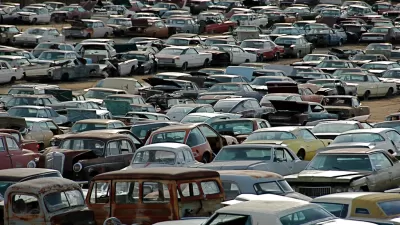While hydrogen fuel cell electric vehicles are much less popular than their battery-powered siblings, California remains committed to the zero-emission technology, with three state agencies investing in and monitoring its progress.

Arnold Schwarzenegger, California's last Republican governor, signed an executive order in April 2004 that launched the so-called Hydrogen Highways (abbreviated as CaH2Net by the California Air Resources Board). Since then, the state has received credit or blame, depending on one's perspective on fuel cell electric vehicles, for California's role as America's testing ground for the feasibility of hydrogen to help decarbonize transportation.
Two years later, the legislature passed Senate Bill No. 1505, which requires a minimum of one-third of the hydrogen to be produced sustainably, no easy task considering that 95 percent of hydrogen in the United States is made from steam-methane reforming of natural gas, a process that releases carbon monoxide and dioxide.
Referring to the initial effort to capitalize on the zero-emission aspect of consuming, if not producing, the world's most abundant element, CalMatters environment reporter Julie Cart writes on Jan 9:
That revolution, part of the battle against climate change, never materialized. The technology remains expensive and hasn’t gained wide traction, ceding the green-transportation crown to battery-powered electric vehicles, which are more widely available and support an ever-growing recharging network.
The Electric Drive Transportation Association, a trade group promoting battery, hybrid, plug-in hybrid and fuel cell electric drive technologies and infrastructure, included FCEVs in their sales data last year. Cumulative totals through the third quarter of 2019 for the three types of electric vehicles (EVs) were:
- Plug-in hybrid EVs: 62,263 [26.2%]
- Battery-only EVs: 173,804 [73.1%]
- Fuel cell EVs: 1,665 [0.7%]
According to the California Fuel Cell Partnership, an industry/government collaboration, as of January 1 there were almost 8,000 FCEVs sold or leased in the United States, with most registered in California, the only state that is building hydrogen fueling retail stations to serve the market, currently numbering 44.
Post-Schwarzenegger
The effort to promote hydrogen as an alternative transportation fuel did not end with Schwarzenegger. His successor, Gov. Jerry Brown, a Democrat, continued the program, albeit without the blue hydrogen Hummer, which burned hydrogen in an internal combust engine as opposed to powering a fuel cell, that Schwarzenegger used at a media event in Los Angeles in October 2004.
Three State Agencies
Tyson Eckerle, deputy director of zero-emission infrastructure in the Governor’s Office of Business and Economic Development (GO-Biz), told Cart the hydrogen's "moment is due. You are starting to see a sea change, as we get more aggressive about meeting our zero-carbon goals."
Only two types of vehicles produce zero tailpipe emissions (other than water vapor)—battery-only electric vehicles, and those powered by fuel cells—in giving consumers limited options for zero-emission vehicles (ZEVs).
The GO-Biz Zero-Emission Vehicle (ZEV) Infrastructure Unit, along with the California Air Resources Board (CARB) and the California Energy Commission (CEC), are guided by Assembly Bill 8, authored by former Assemblyman Henry T. Perea (D-Fresno), one of six bills that Gov. Brown signed in 2013 to promote EVs. It requires the CEC to "allocate $20 million annually... until there are at least 100 publicly available hydrogen-fueling stations in California."
- The commission's "Clean Transportation Program (also known as Alternative and Renewable Fuel and Vehicle Technology Program) invests up to $100 million annually in a broad portfolio of transportation and fuel transportation projects throughout the state."
- CARB administers the Zero-Emission Vehicle (ZEV) Program requiring automakers "to produce a number of ZEVs and plug-in hybrids each year, based on the total number of cars sold in California by the manufacturer...Requirements are in terms of percent credits, ranging from 4.5 percent in 2018 to 22 percent by 2025." InsideEVs explains how the mandate works in terms of ZEV credits. Ten other states [pdf] have adopted the ZEV program under Section 177 of the Federal Clean Air Act.
- Pursuant to AB 8, CARB prepares annual evaluations on how well the hydrogen fuel cell program is doing.
- CARB also administers the Low Carbon Fuel Standard Program that can accelerate the commercialization of FCEVs, hydrogen stations, and renewable hydrogen through its electricity and hydrogen provisions.
Executive Orders
Brown, who took office in January 2010, issued Executive Order B-16-12 in March 2012, calling for 1.5 million zero-emission vehicles by 2025, which built on a CARB modification to its Zero-Emission Vehicle Regulation, approved two months earlier, requiring "the largest automakers to derive 15 percent, or about 1.4 million, of their annual California sales from electric vehicles and other zero or near-zero emissions vehicles."
Gov. Jerry Brown issued a second ZEV executive order the day after his final state of the state address in 2018 that set a new target of 5 million ZEVs in California by 2030. Executive Order (EO) B-48-18 also doubled the AB 8 mandate on hydrogen fueling stations to 200 and called for 250,000 zero-emission vehicle chargers, including 10,000 direct current fast chargers, by 2025.
As noted above, CARB evaluates progress on fueling infrastructure and FCEV adoption. The third "finding" of the 2019 Annual Evaluation of Fuel Cell Electric Vehicle Deployment & Hydrogen Fuel Station Network Development [pdf], released last July, was that "[a]uto manufacturer projections for FCEV deployments do not demonstrate sufficient acceleration to support the FCEV deployment goals of EO B-48-18 and the California Fuel Cell Partnership’s Revolution document." [Emphasis added.]
The evaluation noted a "growth of 1,500 vehicles from the same time last year; while not as large as the growth between 2017 and 2018, the pace of FCEV deployment is largely sustained and auto manufacturer projections provided through the annual survey indicate that acceleration will occur in the next few years."
Hurdles
"Hydrogen fuel is much more efficient than gasoline, but it’s also four times more expensive, roughly equivalent to about $16 a gallon," adds Cart. "A June explosion at a hydrogen production facility in Santa Clara, California, owned by hydrogen producer Air Products shut off the fuel supply to many of the hydrogen filling stations in the San Francisco Bay Area," according to Green Car Reports.
Cart goes on to list several other formidable challenges that may slow adoption of FCEVs, but GO-Biz's Eckerle indicates "that the state has no indication from car makers that they intend to back away from their commitment to making hydrogen vehicles."
One bright note on the horizon for fuel and technology awaits this summer at the Tokyo Olympics, where hydrogen and fuel cell electric vehicles will be promoted by the government. "We are looking forward to surprising the world with our hydrogen technology," stated Toru Muta, deputy director of hydrogen strategy at Japan’s Ministry of Economy, Trade and Industry in an October 2019 article for Shell Global.
Shell's New Energies division is a promoter of hydrogen fuel.
"Hydrogen brings 'a better product and customer choice,' said Wayne Leighty, hydrogen business development manager with Shell New Energies, speaking during the Veloz webinar," reported Skip Descent for Government Technology last April.
“As we launch the commercial introduction of hydrogen fuel cell electric vehicles, we are seeing all the benefits of an electric vehicle, with all the convenience and freedom of refueling,” he added.
Related in Planetizen:
- Gov. Jerry Brown Calls for Five Million ZEVs on California Roads by 2030, January 29, 2018
-
More Fuel Cell Vehicles for Lease in 2017, April 14, 2017
-
California Becomes More EV-Friendly With 6 New Laws, October 3, 2013
FULL STORY: California’s ‘hydrogen highway’ never happened. Could 2020 change that?

Planetizen Federal Action Tracker
A weekly monitor of how Trump’s orders and actions are impacting planners and planning in America.

Chicago’s Ghost Rails
Just beneath the surface of the modern city lie the remnants of its expansive early 20th-century streetcar system.

San Antonio and Austin are Fusing Into one Massive Megaregion
The region spanning the two central Texas cities is growing fast, posing challenges for local infrastructure and water supplies.

Since Zion's Shuttles Went Electric “The Smog is Gone”
Visitors to Zion National Park can enjoy the canyon via the nation’s first fully electric park shuttle system.

Trump Distributing DOT Safety Funds at 1/10 Rate of Biden
Funds for Safe Streets and other transportation safety and equity programs are being held up by administrative reviews and conflicts with the Trump administration’s priorities.

German Cities Subsidize Taxis for Women Amid Wave of Violence
Free or low-cost taxi rides can help women navigate cities more safely, but critics say the programs don't address the root causes of violence against women.
Urban Design for Planners 1: Software Tools
This six-course series explores essential urban design concepts using open source software and equips planners with the tools they need to participate fully in the urban design process.
Planning for Universal Design
Learn the tools for implementing Universal Design in planning regulations.
planning NEXT
Appalachian Highlands Housing Partners
Mpact (founded as Rail~Volution)
City of Camden Redevelopment Agency
City of Astoria
City of Portland
City of Laramie





























